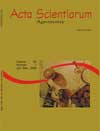<b>Molecular genetic diversity in accesses of saffron using RAPD markers</b> - DOI: 10.4025/actasciagron.v25i1.2671
Abstract
The Saffron, Curcuma longa (Zingiberaceae) assumes a great importance in the food industry, and it is considered as the solution for synthetic coloring. In addition, it can also be used by its medicinal and pharmacological properties. The aim of this work was to analyze the genetic diversity, based on RAPD molecular markers among 20 accesses obtained from different areas of Brazil. For the genetic variability characterization, 45 polymorphic loci were used. The obtained binary data were used to calculate the Jaccard’s index of similarity, which generated the dendrograms following the UPGMA grouping criteria. The formation of 2 groups was verified, where the IAC accesses were distanced, and the ginger ones were used as standard. The structuring of the genetic variability was verified through the Amova. Based on the Amova’s analysis, the proportion of the existent genetic variability among the 3 pre-established accesses allowed verifying 44.49% of genetic variability among the groups and the most part of the variation was found within the groups.Downloads
Download data is not yet available.
Published
2008-04-23
How to Cite
Pinheiro, J. B., Zucchi, M. I., Teles, F. L., & Ázara, N. A. (2008). <b>Molecular genetic diversity in accesses of saffron using RAPD markers</b> - DOI: 10.4025/actasciagron.v25i1.2671. Acta Scientiarum. Agronomy, 25(1), 195-199. https://doi.org/10.4025/actasciagron.v25i1.2671
Issue
Section
Agronomy
DECLARATION OF ORIGINALITY AND COPYRIGHTS
I Declare that current article is original and has not been submitted for publication, in part or in whole, to any other national or international journal.
The copyrights belong exclusively to the authors. Published content is licensed under Creative Commons Attribution 4.0 (CC BY 4.0) guidelines, which allows sharing (copy and distribution of the material in any medium or format) and adaptation (remix, transform, and build upon the material) for any purpose, even commercially, under the terms of attribution.
2.0
2019CiteScore
60th percentile
Powered by 

2.0
2019CiteScore
60th percentile
Powered by 



















































